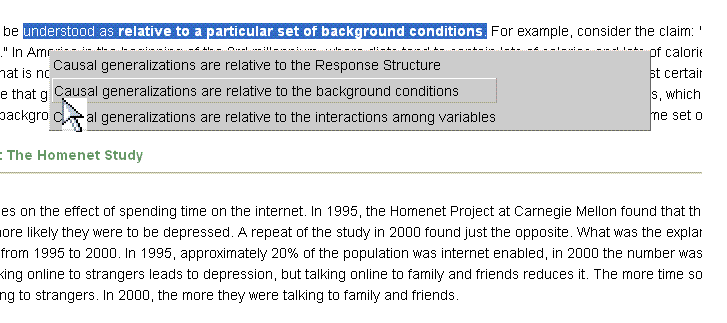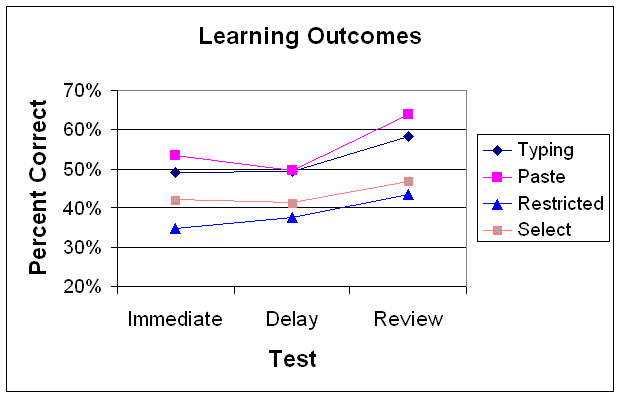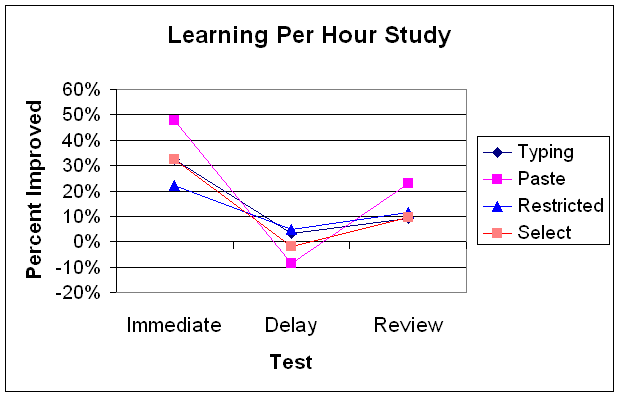Note-Taking: Restriction and Selection
Contents
Abstract
This study evaluates two hypothesis regarding negative learning effects observed for note-taking tools with copy-paste functionality. Two novel tools are compared with two tools that use standard functionality: one that only allows copy-paste, and the other that only allows typing. The first novel tool restricts the amount of text students can select in any one copy-paste action, in order to increase attention to what is being recorded. The second requires students to choose a reworded version of the idea selected, in order to evaluate whether it is important that students create their notes or simply view reworded versions of the ideas they want to record. Our study found that both novel tools performed worse on learning outcomes than the standard tools, which may be due to an observed user frustration with the novel interaction techniques. We also found that copy-paste only functionality increased the efficiency of learning relative to typing. In other words, people using the copy-paste tool learned the same amount in less time than users of the typing tool.
Glossary
Select/ion: This term is used in the context of this study to identify the behavior of using the mouse and cursor to actively highlight a portion of digital text. Selection is first step for several online note-taking techniques, including copy-paste and annotation.
Copy-Paste: This is the act of selecting material, copying it to the computer clipboard (via a keyboard shortcut or menu), and then pasting it into students’ notes.
Highlighting: The act of creating a lasting distinction between the selected text and the main content. For example, through creating a yellow background or underlining the text.
Research Question
Can we improve learning outcomes in online courses by changing the way students can take notes?
Background/Significance
In a previous study, we showed that copy-paste functionality in a note-taking application appears to reduce long-term retention relative to note-taking using typing or handwriting. This study evaluates two hypotheses regarding this effect. In the previous study we found that when using copy-paste functionality, ideas that were recorded in a more wordy fashion were forgotten more than less wordy notes. This was not the case for typed or handwritten notes. As the cost of wordy notes is low using copy-paste, we believed that wordy notes are indicative of decreased attention to the idea being recorded. In addition, while in typing and handwriting wordiness is associated with more time spent on the idea being recorded, this is not the case for copy-paste. We designed a tool to restrict the amount of text students could select in any one copy-paste action in order to increase the attention required to record a note. We believed this would result in superior learning. It is important to note that whereas in our previous study all tools had typing functionality, in this case only users of the typing tool could type.
While students create their own notes through typing or handwriting, they simply copy material verbatim using copy-paste functionality. It may be that rewording of notes is important, or it may be that simply viewing an alternative representation of the learning material in notes is key to learning gains. To tease these apart, we designed a selection tool that, upon a student selecting an idea to record, gave the students three options to place in their notes. One was a reworded version of the idea recorded, and the other two were distractors. If it was only important to view an alternative wording, this tool should show superior performance to copy-paste. If involvement in the rewording was important, the tool should show equivalent performance to copy-paste.
Dependent Variables
Tests
Note: all tests include both multiple choice and free response questions. The multiple choice questions all involve solving problems (for example, given a response structure, which variables are direct causes of an effect, or which interact to produce an effect). In addition, some free response questions ask students to explain terminology used in the module.
Normal Learning, immediate: Students are given a test immediately after studying the material.
Long-Term Retention, Normal Learning: Students return a week following the treatment (which lasts between 30 and 90 minutes) to take this test.
Normal Learning, review: After taking the long-term retention test, students are given their notes to review for 5 minutes. Following this review period, students take a final test.
Behavior
Note-Quantity: The total number of ideas students place in their notes is captured, as well as the number of words used to express those ideas.
Note-Wording: How students word their notes is recorded. Each ideas is either recorded Verbatim, Abbreviated, or in students Own words.
Completion Time: The time students take to complete the learning material is recorded.
Motivation/Interest
Experience: After taking the final test, students are given a survey which solicits their reaction to the tool they used. They are asked to identify their most and least favorite features of the tools, and how they believe the tool affected their note-taking behavior.
Independent Variables
Note-taking Treatment
Paste: Students can only create notes by copy-pasting material from the learning content to their notepad. Students can select as much material as they like in any single pasting action.
Restricted Paste: Students can only create notes by copy-pasting material from the learning content to their notepad. Students are restricted to selecting 90% of the words of any single sentence they are selecting.
Typing: Students can only create notes by typing directly into their notepad.
Selection-Tool: Students can only create notes by choosing one of the 3 options made available when they select learning material.
Highlighting: Students can create notes by actively highlighting course material. These highlights are seen with differently colored backgrounds, as would be the case with a physical highlighter.
Context/Mediating Variables on Student Characteristics
SAT Score: All students are asked to provide their SAT scores, as in previous studies SAT-Math was found to be an important covariate.
Pretest score: Prior to the learning material, students take a pre-test similar to the normal tests described above.
Preferences: In the survey, students are asked how they prefer to take notes in their regular student-life.
Hypotheses
1. 'Refinement': Restrictions on selections will increase the students' focus on the ideas being recorded, resulting in improved learning gains relative to unrestricted copy-paste.
2. 'Coordination': Viewing multiple versions of the same idea will require students to coordinate material, resulting in improved learning gains (less forgetting) relative to copy-paste.
Findings
Learning: The two novel tools (bottom) showed significantly lower learning on all tests than did the standard tools(top two). The two novel tools (Selection and Restricted) were not significantly different from each other. The two standard tools (Copy-Paste and Typing) were not significantly different from each other). There was a significant overall effect for review (tests 2-3) across all conditions, but no significant effect for forgetting (tests 1 to 2).
Efficiency: The Paste condition showed more efficient learning than all other tools on the immediate test (1) and review test (3). Efficiency is defined as learning difference between two subsequent tests divided by the time spend studying the materials.
Ideas Recorded: The Paste tool recorded significantly more total ideas than any other condition, and the same amount of key ideas as the typing condition. The Novel tools recorded significantly fewer key ideas than the standard conditions.
Explanation
- The results of this experiment do not support our hyptheses, as the novel tools performed worse on learning outcomes than did the standard tools. However, this may be due to usability issues. The Selection tool was the most disliked tool, and users reported disliking the restrictions in the restrited-paste tool. In addition, note-taking behavior was suboptimal, as the novel conditions recorded fewer key ideas than did the standard tools. It may be that the design of the novel tools required more attention to the process of note-taking, rather than the product.
- Lesson: More attention must be paid to the design of note-taking interventions, in order to ensure adoption by users.
- When students are only allowed to copy-paste, they appear to learn as much as when they type. Contrary to previous results, they do not forget more over time. In contrast to the previous experiment, students in the copy-paste condition could not type. This may have increased their attention to the process of pasting. In addition, students in the copy-paste condition showed reduced time on task compared to typing.
- Lesson: Copy-Paste may be a more efficient note-taking technique than typing.
Descendents
Further Information
The following is a reference to a conference paper regarding our earlier study contrasting handwriting, typing, and copy-paste.
Bauer, A., Koedinger, K. Pasting and Encoding: Note-taking in Online Courses. IEEE International Conference on Advanced Learning Technologies (ICALT 2006), 5-7 July, Kerkrade, Netherlands.
- Bauer, A., Koedinger. K.R., Selection-Based Note-Taking Applications, ACM Symposium on Human Factors in Computing Systems 2007, in submission



